The rich diversity of the animal kingdom is awe-inspiring. Animals differ from one another in terms of their genetic makeup, anatomical, and physiological characteristics. But have you ever wondered which animals have the biggest teeth?
The anatomy of an animal’s dentition reflects its diet. For example, carnivores use canine teeth to attack prey and pull meat, while herbivorous animals have many molars to chew and crush hard-to-digest plant matter. Only mammals exhibit the incisor, canine, premolar, and molar tooth arrangement. In mammals with tusks, the growth of the tusks is nearly constant.
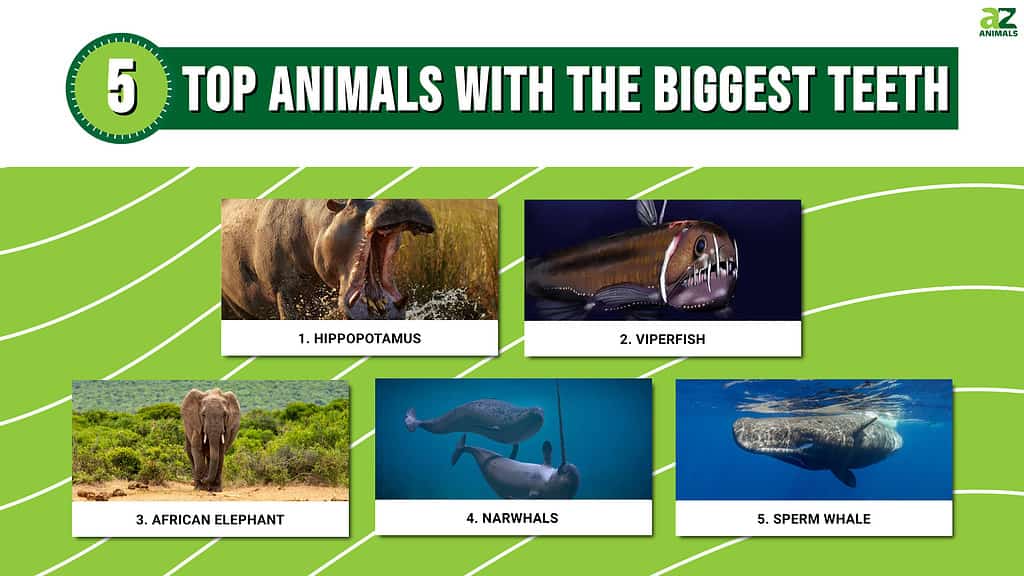
Reptiles tend to have simple, conical-shaped teeth, but there are some species-specific variations, especially the fangs of venomous snakes. Amphibians have minimal to no teeth because of the nature of their diet.
A handful of animals only have one set of teeth (monophyodonts), but most mammals are diphyodonts, meaning they have baby teeth first, and later develop permanent teeth in adulthood. However, some animals continually replace their teeth throughout their lives (polyphyodonts). This category includes manatees, sharks, elephants, and kangaroos.
#1 Hippopotamus
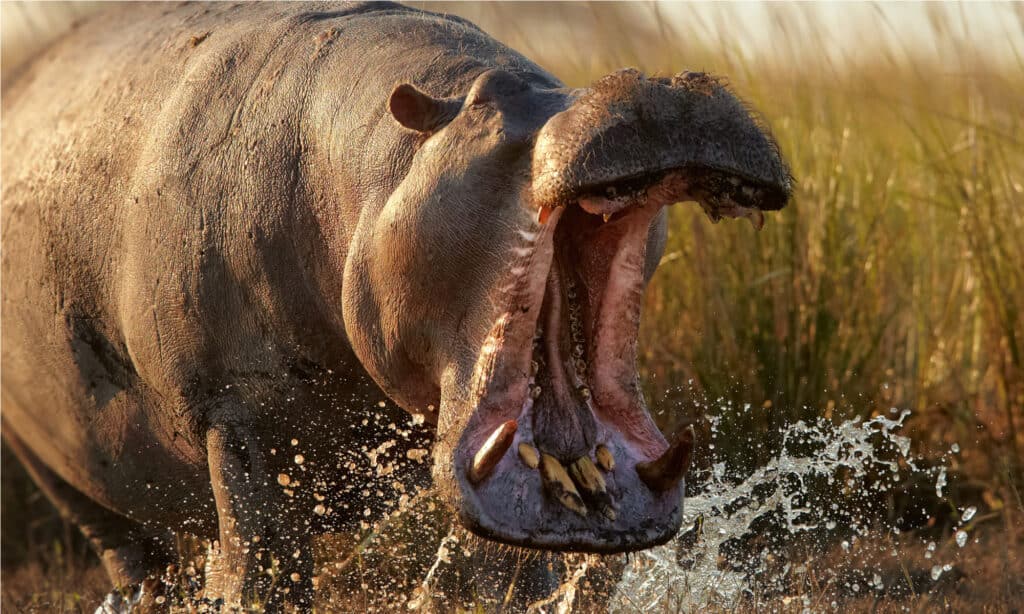
Hippos are enormous semi-aquatic creatures typically found in shallow lakes, mangrove swamps, and rivers.
©Martin Mecnarowski/Shutterstock.com
Sub-Saharan Africa is home to hippopotamuses, the third-largest living land mammal after elephants and white rhinoceros. Hippos are enormous semi-aquatic creatures that inhabit shallow lakes, mangrove swamps, and rivers. Males can grow to be between 10.8 and 16.5 feet long and up to 9,920 pounds, while females can weigh up to 3,000 pounds.
Except for the dense, bristle-like hair on their heads and tails, their hair is thinly spread. As a result, the outer skin layer is so thin hippos are susceptible to injuries from fights. Their short legs provide strong propulsion through the water, while their webbed feet distribute their weight and sustain them on land. Surprisingly, they can travel a short distance at speeds of up to 22 mph.
These barrel-shaped mammals are distinguishable by their conspicuously massive mouth and teeth used to repel threats. They use their razor-sharp canines, which may reach 20 inches in length, for combat, while they use their molars for eating. Hippos shred and soften their food, rather than chewing it, to retain optimum nutrients. Grasses, reeds, and tiny shoots make up the bulk of their herbivorous diet. Despite their sedentary lifestyle, they eat 1 to 1.5% of their total weight every night. Their incredible jaw strength allows them to expand their mouth up to 150 degrees, and their bite is almost three times as powerful as that of a lion‘s. In fact, a single hippo bite can split a human body in half.
Pygmy hippos, the only other species of hippos still alive, are smaller than common hippos. They don’t have sweat glands or odor. Instead, mucous glands secrete an oily liquid. This reddish liquid shields them from sunburn.
Hippopotamuses can’t swim, float, or breathe underwater, but they have figured out a way to take naps while in the water. They can see and breathe while mostly submerged because their eyes and nostrils are on top of their heads. When submerging fully, their ears and nostrils tightly close.
They are at risk of going extinct, according to the International Union for Conservation of Nature. Poaching, habitat loss, and human conflicts are the main reasons for the population decline.
#2 Viperfish
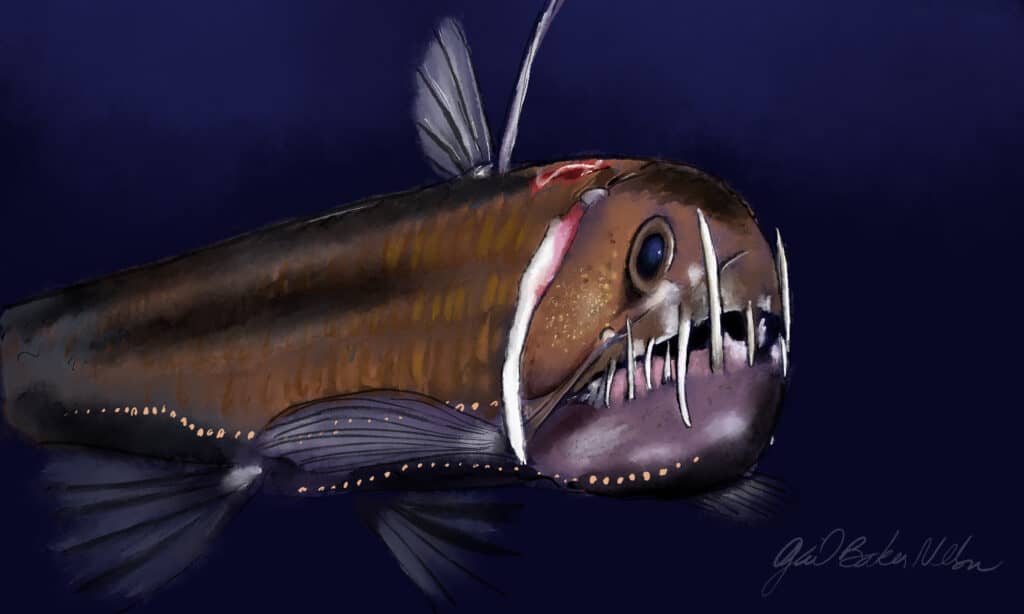
Sloane’s viperfish or Sloane’s fang fish are common names for the viperfish (Chauliodus sloani), one of the strangest-looking and ferocious fish of the deep sea. They exist in the marine waters of tropical and temperate regions at depths of up to 9,000 feet. Despite its intimidating look, the viperfish grows to a maximum length of only around 11 or 12 inches. Its color can range from green to silver to black, although it is usually a dark silvery blue. They have a low basal metabolic rate, like other Chauliodus species.
The species gets its name from its sharp, fang-like teeth. Their teeth are so long that they protrude from the jaws, curving sharply back toward the fish’s eyes. These needle-like teeth impale prey while viperfish swim at a rapid pace. The first vertebra, located directly behind the head, serves as a shock absorber.
Viperfish migrate in a daily asynchronous cycle. Typically, they inhabit deep water, up to 5,000 feet deep, during the day. However, they ascend to shallower waters 600 meters or less at night in search of food.
The formidable predators feed on crustaceans and bony fishes. They have several deep-water fish-specific traits that make it easier for them to find food in low-light environments. These characteristics include a distensible, lengthy stomach and a straight intestine. In addition, the ability of their uniquely large teeth to turn inward allows prey to enter the gullet more easily, while preventing escape. The lateral and ventral surfaces of the fish are covered in rows of 24 or more photophores (light-producing cells). In a process known as bioluminescence, they use this light to entice prey, communicate with prospective mates, and warn competitors.
Humans rarely encounter them because their deep-sea habitats insulate their populations from human activities. However, deep ocean trawlers are sometimes lucky enough to catch a specimen of this species. These captures offer a rare and invaluable opportunity for scientific research on the elusive viperfish.
#3 African Elephant

Adult African elephants possess lophodont dentition, a set of six moving, growing molars.
©Carfield Photography/Shutterstock.com
African elephants need no introduction; they are the biggest living land mammals in the world. Their wide triangular ears, which keep them cool throughout the dry season, distinguish them from their Asian counterparts. The sub-Saharan African savannas and the rainforests of Central and West Africa are home to African elephants. They can also be found as far north as the Sahel Desert in Mali. However, protected sanctuaries are their primary habitats because of the threat of poaching.
The two species of African elephants include savanna or bush (L. africana) and forest (L. cyclotis). They differ in skull and skeleton size and shape. African forest elephants are smaller, darker, and have a straighter, downward-pointing tusk, while the bush elephants are larger with tusks that bend outward.
African elephants’ grey, folded skin can be up to 1.2 inches thick, and they grow sparse, bristling, dark brown to black hair. They often spray their skin with dust to protect it. The trunk, which has short tactile hairs and two fingerlike appendages at the tip, is used for breathing, grabbing, drinking, smelling, and trumpeting. In fact, the trunk reportedly contains about 40,000 muscles! Because elephants love water, they also use their unique trunks to soak up water and shower themselves.
Adult African elephants possess lophodont dentition, a set of six moving, growing molars. About four to six times throughout an elephant’s life, their teeth deteriorate and regrow. As they get older, they’re unable to replace these molars needed to process food and may starve to death. Tusks on both sexes of African elephants develop from tushes, which are like milk teeth in humans that fall out when calves are about a year old. Tusks are mostly used for feeding-related activities, including digging for roots and removing tree bark. They are also useful for protection against predatory attacks and fights during the mating season. Tusks can range in length from 1.5 to 2.4 meters and weigh between 23 and 45 kilograms. They curl forward and continue growing during an elephant’s life.
The IUCN Red List rates both species of African elephants as having a high risk of going extinct. The forest and bush elephant species are classified as critically endangered and endangered, respectively, as of 2021. They face threats from habitat degradation, fragmentation, and ivory-related poaching.
#4 Narwhals
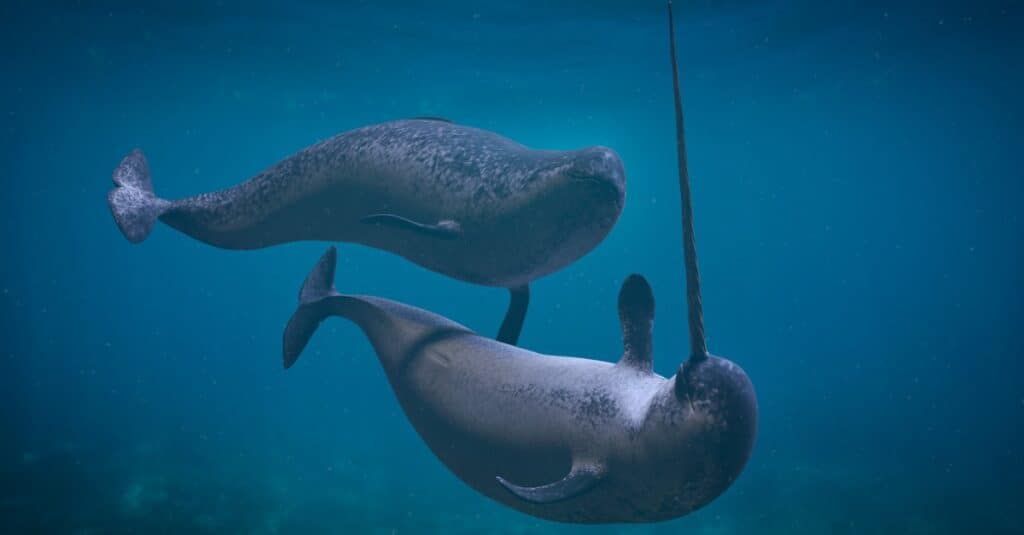
A male narwhal’s “horn” is actually a protruding tooth!
©iStock.com/dottedhippo
This list isn’t complete without the unicorn of the sea. The iconic Narwhal is a light-colored porpoise that inhabits the deep Arctic waters of Canada, Greenland, Norway, and Russia. It is regarded as the most northern cetacean, often found between latitudes of 70° and 80°N, though they migrate on a seasonal basis. Narwhals are visible in the summertime in the northern Canadian Arctic, close to Greenland’s eastern coast. In late September, most narwhals start their southern migration to Baffin Bay, where they spend the winter. The color of narwhals changes with age. As infants, they are a blue-gray color, while during adolescence they turn a blue-black color. In adulthood, they are mottled gray. Interestingly, old narwhals are almost entirely white!
Their diet changes according to the season. Narwhals consume more during the winter and less in the summer when there is no ice. Some components of their restricted diet include squid, shrimp, Arctic, polar cod, Greenland halibut, skate eggs, cuttlefish, and capelin. Their feeding cycle differs from that of other sub-Arctic whale species; they typically feed in the summer and move south during the winter. According to scientists, the heavy winter-feeding period of the narwhal may be a behavioral trait to avoid competition with whales eating in summer, or it may be an adaptation to the low productivity of food in the high Arctic summering zones.
Narwhals do not have traditional teeth. However, males grow a prominent, long tooth that sticks out from the left side of the upper jaw. This straight tusk can grow to be as long as half of the whale’s typical 16-foot body length. It’s the only spiral tooth in nature, and it grows in a counterclockwise spiral. Females rarely have the famous tusk, but their lifespan is equal to that of males, proving that the tusk must not be essential to the narwhal’s survival. Biologically, the tusk exerts dominance among males. However, it could also work as a sexual trait to vie for female attention and a visual cue to help females select a partner. The legendary tusk is the source of the unicorn myth. When European whalers traveled to the Arctic, they caught narwhals and brought their tusks back, along with fascinating tales about the animals to which they belonged.
#5 Sperm Whale
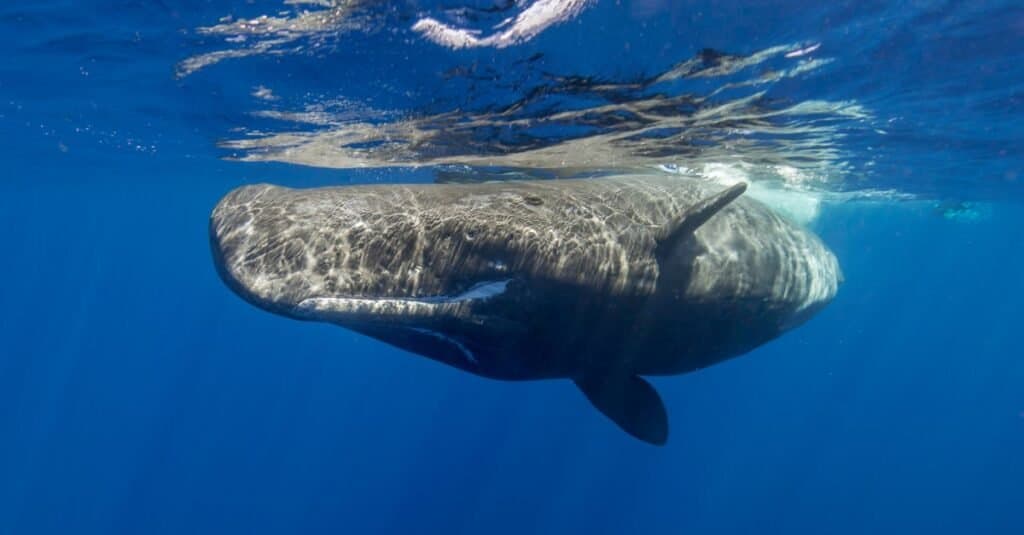
The huge, conical teeth of the sperm whale capture their favorite prey, which includes squid, sharks, and fish.
©wildestanimal/Shutterstock.com
The sperm whale is unique in many ways: It’s the largest of about 73 species of toothed whales, it has the largest brain of any animal on Earth, and it has one of the widest ranges of any marine mammal. It dwells in deep oceans everywhere, from the Arctic to the Antarctic.
The name derives from spermaceti, a waxy substance in their heads, which was once used to produce candles, oil lamps, and lubricants. Ambergris, a solid waxy waste material that accumulates in a whale’s stomach, is prized for use as a fixative in perfumes.
They have enormous, block-shaped heads that can be between one-quarter and one-third of their body length. Their huge, conical teeth capture their favorite prey, which includes squid, sharks, and fish. They can dive to tremendous depths (up to 1000 meters) and stay underwater for extraordinarily long periods (up to two hours), increasing their chances of finding prey.
The Marine Mammal Protection Act and the Endangered Species Act both categorize sperm whales as depleted and endangered. However, with the end of commercial whaling in many places, they are gradually regenerating.
The photo featured at the top of this post is © Nejron Photo/Shutterstock.com
Thank you for reading! Have some feedback for us? Contact the AZ Animals editorial team.






